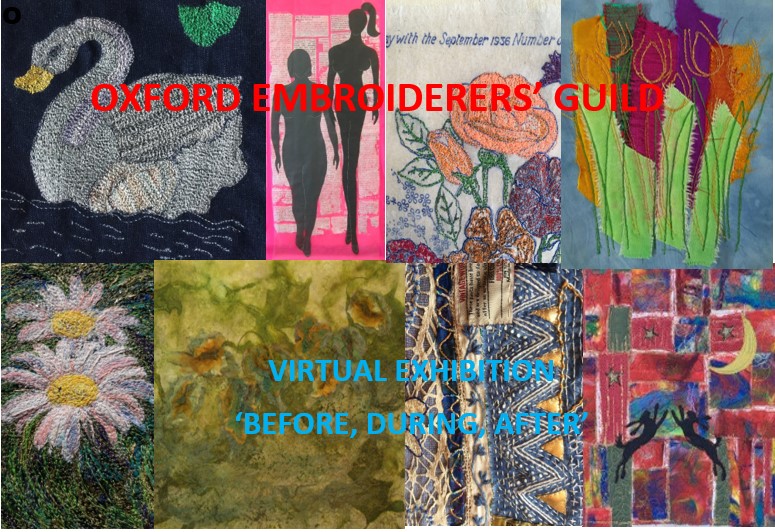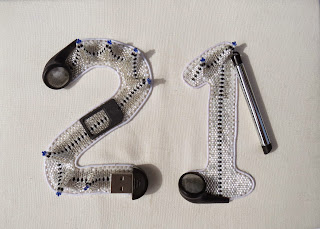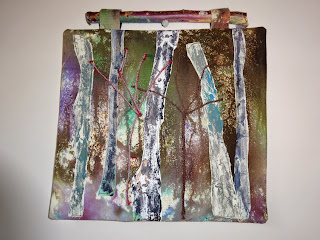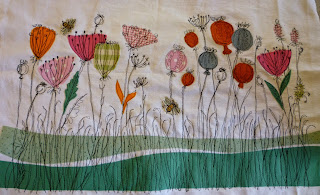Yulia first took us through an installation project entitled Woodland Boudoir which was shown at the Knitting & Stitching Show 2013. The idea had come about over a glass of wine (or three) shared with friends during a stay in Yorkshire. As can be the way when a group of creative women get together, they decided to work together and share their skills to create an installation project which would tell stories of their lives through fairy tales. Whilst you may think of the surface innocence of stories from Brothers Grimm and Hans Christian Andersen, such tales often had undercurrents running through them where the woods stood to represent female sexuality, a place that young girls could get lost in but which was inhabited by mature women in tune with both nature and themselves (at least that’s how these ladies chose to view it !!)
©
Silkfelt
Yulia finds working in a group very inspirational and she worked with 7 others to create this work which includes not only felt but woven willow (by Debbie Hall), hand painted wallpaper (Hannah Stippl and Anita Duller) and embroidery (Gilda Baron). Yulia had a good range of photos that showed how meticulously made and varied the pieces were, some being multi layered and she explained how these were done. There were technical problems along the way, but Yulia is a positive and resilient person, so found a way round them – including jetting off to Holland barely days before the show to use large-scale felting machines.
It was over another glass (or three) of wine that the next project took shape – The Mermaid Project (shown at K&S 2014). A conversation which started along the lines of "what women do to change their bodies and all for the sake of love" culminated in the idea that The Little Mermaid made the ultimate sacrifice in using cosmetic surgery to try and catch her man. "A shape-shifting figure for our own times, a tragic heroine who seeks to transform her appearance in order to get what (she thinks) she wants, and in the process destroys her own beauty and ultimately herself." There was much laughter and ribaldry at the suggested props required to turn a pretty little mermaid into a middle-aged woman…. followed by what middle-aged women do to keep up appearances (and we don’t mean elocution lessons from Hyacinth Bucket). To quote their thoughts "We all resonate with the lure of the quick fix the sweet banter of the witch. Luring us with our insecurities promising to fulfill our desire for love with her lotions and potions, shaving, lifting, filling, tucking our flesh as short cuts to a happier life."
Using felt, Yulia, Rosi and Linda addressed all these themes. I must admit to getting a bit lost at this point… I wasn’t quite sure how a piece which seemed (to me) to be seahorses and was entitled "Shotgun Wedding" came out of The Little Mermaid idea. Made from Bergschaf (wool from Austrian sheep), Teeswater curls, Silk, Horsehair, French Lace, Silicone, shells all wet felted over various armatures, it was nonetheless an interesting and clever trio of pieces. I could understand the pink legs, cross-stitched all down the back, and appreciate the full length felted and slashed Sea Witch coat, but I wasn’t sure about a twisted, gnarled and felted shape representing the witch itself. Many of the pieces are 3d and Yulia explained some of the clever techniques used to create them – such as felting around shapes which are cut out when it is dry so the 3d shape is maintained.
©
Silkfelt
Now, if you embarrass easily or prefer not to know the more intimate type of other props they created, feel free to skip this paragraph. The Mermaid idea then moved into colourful phallic shapes and pale hymen-busters complete with beaded edges (cutely entitled Honeymoon Fresh) followed by a set of mounted merkins (genital wigs as used by stars of film and theatre and, apparently, a lot of oriental ladies). By now our audience had dissolved into a giggling mass of amusement, both from discovering such things existed and seeing how they were being portrayed in felt and other materials.
Obviously Yulia and her co-workers can get a lot of mileage from one idea. The phrase "impossible textiles" is one that is associated with this sort of work – the type of image that you can see in your head but wonder how on earth you will actually create it. One of her collaborators – Sue Walton – did a similar thing with Jabberwocky – "a surreal tableau inspired by the vivid imagination Lewis Carroll… where sculpted felt combines with contrasting and diverse materials". If you’ve never seen it, have a look on www.suewalton.co.uk.
©
Silkfelt
There is no doubt that Yulia has an ethical approach to the materials she uses – for example, preferring wool from sheep that have lived as naturally as possible. She is a lady now comfortable in her own skin and that comes across in her work. Her presentation was natural and fun, scattered with anecdotes about how she got to where she is now, but can be thought provoking if you look beyond the initial ideas. Her Facebook page has lots more interesting stuff if you like her work and want to know what she is currently thinking about. This was a side of felt-making that I had not seen before and I had not appreciated how stunning it could look when done on such a large scale. She knows her subject, and if you’d like an evening with a capital E for entertainment, then look no further than Yulia.




















































